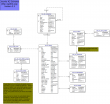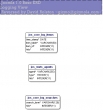Joomla K2 Component ERD Schema and Tree traversal optimization with Catalog Mode
In the recent profile of GB4K.com, I talked about the use of the K2 component from the Folks at JoomlaWorks. While doing some customization, I decided to reverse engineer the K2 tables that are created and used by the component. I provide the diagrams for interested parties and developers looking to understand how K2 is designed. Keep in mind that these are logical diagrams, since Joomla and K2 have no intrinsic support for MySQL other than using the MyISAM engine, which doesn't support key constraints. Click on the image to get the .png version, or this link for a .pdf.
One thing I noticed about K2, is that its tree traversal code can require a lot of queries to be run, especially if you have a lot of categories. Over on the K2 forums, one K2 user with a large number of subcategories was complaining about the substantial overhead involved in displaying the top level Category for their site. With over 1000 subcategories, the site was being hammered with an equal number of queries.
This is because by default K2 will do a query for every category to find its child categories and items. Since this is a recursive problem there's no inherent MySQL solution that would allow the developers to solve this problem in SQL (like the Oracle Start With ... Connect By syntax) so it's somewhat understandable that the JoomlaWorks developers provided a short circuit mechanism into the category configuration they call "Catalog Mode". The description of this configuration flag, which defaults to "No" is:
This setting simply shuts off the recursion behavior for the category.
One thing I noticed about K2, is that its tree traversal code can require a lot of queries to be run, especially if you have a lot of categories. Over on the K2 forums, one K2 user with a large number of subcategories was complaining about the substantial overhead involved in displaying the top level Category for their site. With over 1000 subcategories, the site was being hammered with an equal number of queries.
This is because by default K2 will do a query for every category to find its child categories and items. Since this is a recursive problem there's no inherent MySQL solution that would allow the developers to solve this problem in SQL (like the Oracle Start With ... Connect By syntax) so it's somewhat understandable that the JoomlaWorks developers provided a short circuit mechanism into the category configuration they call "Catalog Mode". The description of this configuration flag, which defaults to "No" is:
If you select 'yes' then only the items directly belonging to this category will be retrieved. If you select 'no' then items from all sub-categories will be retrieved. Setting this option to 'no' is ideal for news/portal/magazine/blog layouts.
This setting simply shuts off the recursion behavior for the category.






